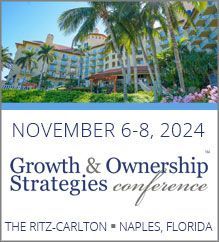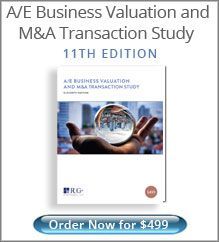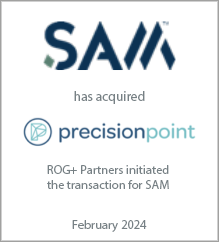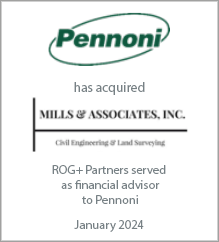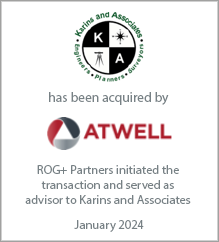Steve Gido specializes in corporate financial advisory services with a focus on mergers and acquisitions. Steve has assisted architecture, engineering, environmental consulting and construction firms of all sizes across North America achieve their growth or liquidity goals through successful mergers & acquisitions. Steve has over 15 years of investment banking experience and holds the chartered financial analyst (CFA) designation from the CFA Institute.
2014 M&A Outlook – Where are the Future A/E Leaders?
2014 M&A Outlook – Where are the Future A/E Leaders?
February 11, 2014
A number of years ago, we represented a mid-sized, highly regarded environmental consulting firm. Despite the full impact of the recession at the time, the company was growing, profitable, and had a surging backlog of new opportunities. The group had a great culture and a clearly defined program for transferring shares internally. In fact, the ratio of shareholders to employees was an extensive 1:3. Why did they sell?
No one was willing to step up from a leadership perspective.
The president sighed as he admitted to me that while his passionate younger staff loved the scientific challenges of solving complex environmental and water issues, not one of them had either the acumen or the passion to assume an executive role. No one was interested in reading a balance sheet, dealing with mundane yet critical administrative matters, working with a bank or insurance agency, or setting the organization’s course for the next 10+ years. A sober, yet revealing scenario.
Over the past few months alone, I have heard the following statements from A/E leaders of various disciplines and sizes:
“We have great project managers and technical staff, but as I look around here no one really has that fire in the belly to take over my spot.”
“I was hoping to retire next year, but am going to have to extend that indefinitely until we see if Tim is up to the task. If not, we’ll be looking to sell.”
“After I couldn’t convince Tracy to take the President spot, I may have to consider an outsider, which is something we’ve never tried before.”
Sound familiar? Over the last few years, this has become a growing refrain from presidents and principals seeking a firm merger or sale. Traditionally it’s the ownership transition dilemma: the difficulty in effectively moving blocks of stock from one generation to the next, that forces owners into the arms of a larger suitor. Only a small firm problem you say? Nope. You’d be surprised at the scarcity of future leadership talent at some ENR 500 firms, many of which are reliant (to the point of paralysis!) on the decisions of one or two senior people for making the organization function.
That being said, please know we are fully aware that our industry has tens of thousands of smart, ambitious, and influential young people and future leaders who will be moving A/E firms into the 21st century. We interact with them on client engagements and at industry events, and always come away very impressed. Many firms today have mentoring and coaching programs in place to nurture their junior team members, and while it’s convenient to make generational stereotypes with challenges like this, the good news is that more organizations are becoming pro-active in identifying and cultivating their leadership ranks.
The basic predicament for the industry, however, is the dual problem of leadership quantity and quality.
We should all be familiar with the quantity dilemma by now. In short, there are too many A/E firms led by too many baby boomer partners and owners (born between 1946 and 1964) and not enough Generation X staffers (born between 1965 and 1983) coming behind them. To make matters worse, the internet boom of the 1990s convinced many engineering majors to instead pursue IT career paths, similar to how the recent building bust has discouraged thousands from studying architecture today. So while the intent to pass the torch internally might be there, oftentimes the math is difficult to make work. A/E firms a generation ago could select from 8 to 10 eager “up and comers” for the top slot; now many only have 1 or 2 choices, if any.
The other issue is one of quality, or at least perceptions of it. It’s common that today’s A/E leaders, often first generation owners in particular, can be quick to offer a list of limiting factors (lack of work ethic, appetite for risk, or the desire to lead) as to why no one individual is ready to lead their firm. Maybe those reasons are legitimate and maybe not, but for founders there could also be underlying issues of control, ego, enjoyment of work/purpose, or a general fear of implementing change, that need to be confronted. Too often a response from young professionals is that they indeed have the aspirations and talents to lead, if only those above them would train, develop, and groom them. It’s a double-edged sword argument we hear all too often.
So, in the long-run, how will the potential lack of effective leadership succession influence future M&A activity and tactics? Three thoughts:
3. In the context of cutting a deal, key owners without budding leaders may have to accept lower valuations, lengthier or more stringent employment agreements, carve-out deal proceeds to key non-owners, or allow junior members to participate in earnout arrangements.
***
After a lethargic year of industry deal making in 2013, we remain cautiously optimistic for a better 2014. Design and construction activity are steadily rebounding – evidenced by an improved AIA billings index, E&C stock prices, and overall construction spending (at a 5-year high!). Anecdotally, our recent discussions with a wide number of U.S. and international leaders of all disciplines have most gearing up for growth and eager to accelerate their presence and scale through M&A (see AMEC’s recent announcement to acquire Foster Wheeler for $3.2 billion which could portend more large scale, “transformational” combinations). Private equity firms continue to express interest in our sector, either with “platform” opportunities or bolt-on deals. As with any transaction, careful planning, managing expectations, and focused execution are more than half the battle!
At Rusk O’Brien Gido + Partners, we possess strong relationships and years of experience navigating A/E and environmental buyers and sellers through the M&A process and towards winning combinations. Whether you are seeking to grow through acquisitions or by evaluating your firm’s strategic and ownership alternatives, please contact us as to how we can help your organization.
No one was willing to step up from a leadership perspective.
The president sighed as he admitted to me that while his passionate younger staff loved the scientific challenges of solving complex environmental and water issues, not one of them had either the acumen or the passion to assume an executive role. No one was interested in reading a balance sheet, dealing with mundane yet critical administrative matters, working with a bank or insurance agency, or setting the organization’s course for the next 10+ years. A sober, yet revealing scenario.
Over the past few months alone, I have heard the following statements from A/E leaders of various disciplines and sizes:
“We have great project managers and technical staff, but as I look around here no one really has that fire in the belly to take over my spot.”
“I was hoping to retire next year, but am going to have to extend that indefinitely until we see if Tim is up to the task. If not, we’ll be looking to sell.”
“After I couldn’t convince Tracy to take the President spot, I may have to consider an outsider, which is something we’ve never tried before.”
Sound familiar? Over the last few years, this has become a growing refrain from presidents and principals seeking a firm merger or sale. Traditionally it’s the ownership transition dilemma: the difficulty in effectively moving blocks of stock from one generation to the next, that forces owners into the arms of a larger suitor. Only a small firm problem you say? Nope. You’d be surprised at the scarcity of future leadership talent at some ENR 500 firms, many of which are reliant (to the point of paralysis!) on the decisions of one or two senior people for making the organization function.
That being said, please know we are fully aware that our industry has tens of thousands of smart, ambitious, and influential young people and future leaders who will be moving A/E firms into the 21st century. We interact with them on client engagements and at industry events, and always come away very impressed. Many firms today have mentoring and coaching programs in place to nurture their junior team members, and while it’s convenient to make generational stereotypes with challenges like this, the good news is that more organizations are becoming pro-active in identifying and cultivating their leadership ranks.
The basic predicament for the industry, however, is the dual problem of leadership quantity and quality.
We should all be familiar with the quantity dilemma by now. In short, there are too many A/E firms led by too many baby boomer partners and owners (born between 1946 and 1964) and not enough Generation X staffers (born between 1965 and 1983) coming behind them. To make matters worse, the internet boom of the 1990s convinced many engineering majors to instead pursue IT career paths, similar to how the recent building bust has discouraged thousands from studying architecture today. So while the intent to pass the torch internally might be there, oftentimes the math is difficult to make work. A/E firms a generation ago could select from 8 to 10 eager “up and comers” for the top slot; now many only have 1 or 2 choices, if any.
The other issue is one of quality, or at least perceptions of it. It’s common that today’s A/E leaders, often first generation owners in particular, can be quick to offer a list of limiting factors (lack of work ethic, appetite for risk, or the desire to lead) as to why no one individual is ready to lead their firm. Maybe those reasons are legitimate and maybe not, but for founders there could also be underlying issues of control, ego, enjoyment of work/purpose, or a general fear of implementing change, that need to be confronted. Too often a response from young professionals is that they indeed have the aspirations and talents to lead, if only those above them would train, develop, and groom them. It’s a double-edged sword argument we hear all too often.
So, in the long-run, how will the potential lack of effective leadership succession influence future M&A activity and tactics? Three thoughts:
1. It could accelerate it. Simply add this challenge to the growing list of reasons A/E owners are deciding to sell (for purposes such as maximizing shareholder value, removing professional and personal liabilities, diversifying financial holdings, as well as concerns over health and personal/family reasons, or an increasing higher tax and regulatory climate, etc.). Time to take the firm out to market.
2. It could soften it. Unless it’s a “body shop” transaction, buyers typically want an organization with some number of promising individuals who can motivate others, sell work, participate at the strategic level, and contribute to the long-term direction of their firm. Candidly, they don’t necessarily want all “top-heavy” aged leaders whose best days are behind them. Lack of bench strength in any type of professional services firm, big or small, can turn off suitors.
***
After a lethargic year of industry deal making in 2013, we remain cautiously optimistic for a better 2014. Design and construction activity are steadily rebounding – evidenced by an improved AIA billings index, E&C stock prices, and overall construction spending (at a 5-year high!). Anecdotally, our recent discussions with a wide number of U.S. and international leaders of all disciplines have most gearing up for growth and eager to accelerate their presence and scale through M&A (see AMEC’s recent announcement to acquire Foster Wheeler for $3.2 billion which could portend more large scale, “transformational” combinations). Private equity firms continue to express interest in our sector, either with “platform” opportunities or bolt-on deals. As with any transaction, careful planning, managing expectations, and focused execution are more than half the battle!
At Rusk O’Brien Gido + Partners, we possess strong relationships and years of experience navigating A/E and environmental buyers and sellers through the M&A process and towards winning combinations. Whether you are seeking to grow through acquisitions or by evaluating your firm’s strategic and ownership alternatives, please contact us as to how we can help your organization.
Latest Perspective
Perfecting the A/E Exit Strategy – Five Key Factors
An enormous A/E generation that kicked off their careers in the 1980s and subsequently started firms or became owners in the 1990s ...
© 2024
Rusk O'Brien Gido + Partners, LLC
Financial Experts for Architects, Engineers, and Environmental Consulting Firms


